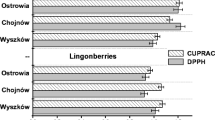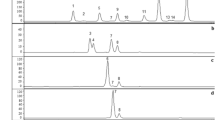Abstract
The present study aimed to evaluate the contribution of anthocyanin composition to the total antioxidant capacity (TAC) of berries having different anthocyanin composition; blackberry, black currant, and blueberry. Blackberry demonstrated the highest TAC, while it had the lowest total anthocyanin content among the three berries in both of the phenolic extract and anthocyanin fractions. On the other hand, black currant had the highest total anthocyanin content, but the lowest TAC. Cyanidin-3-O-glucoside (cya-3-glc) accounted for 94 % of blackberry anthocyanins, and as one of the strongest antioxidants present in these three berries, it substantially contributed to the TAC of blackberry anthocyanin fraction (96.0 %). Delphinidin-3-O-rutinoside and cyanidin-3-O-rutinoside in black currant had lower antioxidant capacities compared with delphinin-3-O-glucoside and cya-3-glc, resulting in its lowest TAC among berry anthocyanin fractions examined. Malvidin derivatives, major anthocyanins of blueberry, had considerably lower antioxidant capacity than other anthocyanidin derivatives, such as cyanidin or delphinidin, resulting in lower TAC of blueberry compared with blackberry. Our findings indicate that anthocyanin composition as well as the antioxidant capacity of individual anthocyanins contributes to the TAC of berries rich in distinct anthocyanins.
Similar content being viewed by others
References
He J, Giusti MM (2009) Anthocyanins: natural colorants with health-promoting properties. Annu Rev Food Sci Technol 1:163–187
You Q, Wang B, Chen F, Huang Z, Wang X, Luo PG (2011) Comparison of anthocyanins and phenolics in organically and conventionally grown blueberries in selected cultivars. Food Chem 125:201–208
Paredes-Lopez O, Cervantes-Ceja ML, Vigna-Perez M, Hernandez-Perez T (2010) Berries: improving human health and healthy aging, and promoting quality life–a review. Plant Foods Hum Nutr 65:299–308. doi:10.1007/s11130-010-0177-1
Tulio AZ, Jr., Reese RN, Wyzgoski FJ, Rinaldi PL, Fu R, Scheerens JC, Miller AR (2008) Cyanidin 3-rutinoside and cyanidin 3-xylosylrutinoside as primary phenolic antioxidants in black raspberry. J Agric Food Chem 56:1880–1888.
Kim D-O, Lee CY (2004) Comprehensive study on vitamin C equivalent antioxidant capacity (VCEAC) of various polyphenolics in scavenging a free radical and its structural relationship. Crit Rev Food Sci Nutr 44:253–273
Rossi A, Serraino I, Dugo P, Paola RD, Mondello L, Genovese T, Morabito D, Dugo G, Sautebin L, Caputi AP, Cuzzocrea S (2003) Protective effects of anthocyanins from blackberry in a rat model of acute lung inflammation. Free Radic Res 37:891–900
Stefanut MN, Cata A, Pop R, Tanasie C, Boc D, Ienascu I, Ordodi V (2013) Anti-hyperglycemic effect of bilberry, blackberry and mulberry ultrasonic extracts on diabetic rats. Plant Foods Hum Nutr 68:378–384. doi:10.1007/s11130-013-0380-y
Seeram NP, Adams LS, Zhang Y, Lee R, Sand D, Scheuller HS, Heber D (2006) Blackberry, black raspberry, blueberry, cranberry, red raspberry, and strawberry extracts inhibit growth and stimulate apoptosis of human cancer cells in vitro. J Agric Food Chem 54:9329–9339
Devareddy L, Hooshmand S, Collins J, Lucas E, Chai S, Arjmandi B (2008) Blueberry prevents bone loss in ovariectomized rat model of postmenopausal osteoporosis. J Nutr Biochem 10:694–699
Vinson JA, Su XH, Zubik L, Bose P (2001) Phenol antioxidant quantity and quality in foods: fruits. J Agric Food Chem 49:5315–5321
Marja PK, Johanna H, Velimatti O, Marina H (2003) Berry anthocyanins: isolation, identification and antioxidant activities. J Sci Food Agric 83:1403–1411
Moyer RA, Hummer KE, Finn CE, Frei B, Wrolstad RE (2002) Anthocyanins, phenolics, and antioxidant capacity in diverse small fruits: vaccinium, rubus, and ribes. J Agric Food Chem 50:519–525
Fernandes I, Faria A, Azevedo J, Soares S, Calhau C, De Freitas V, Mateus N (2010) Influence of anthocyanins, derivative pigments and other catechol and pyrogallol-type phenolics on breast cancer cell proliferation. J Agric Food Chem 58:3785–3792
Yi L, Chen CY, Jin X, Mi MT, Yu B, Chang H, Ling WH, Zhang T (2002) Structural requirements of anthocyanins in relation to inhibition of endothelial injury induced by oxidized low-density lipoprotein and correlation with radical scavenging activity. FEBS Lett 584:583–590
Kim DO, Chun OK, Kim YJ, Moon HY, Lee CY (2003) Quantification of polyphenolics and their antioxidant capacity in fresh plums. J Agric Food Chem 51:6509–6515
Im SE, Nam TG, Lee H, Han MW, Heo HJ, Koo SI, Lee CY, Kim DO (2013) Anthocyanins in the ripe fruits of Rubus coreanus Miguel and their protective effect on neuronal PC-12 cells. Food Chem 139:604–610
Miller NJ, Rice-Evans C, Davies MJ, Gopinathan V, Milner A (1993) A novel method for measuring antioxidant capacity and its application to monitoring the antioxidant status in premature neonates. Clin Sci (Lond) 84:407–412
Wu X, Prior RL (2005) Systematic identification and characterization of anthocyanins by HPLC-ESI-MS/MS in common foods in the United States: fruits and berries. J Agric Food Chem 53:2589–2599
Sellappan S, Akoh CC, Krewer G (2002) Phenolic compounds and antioxidant capacity of Georgia-grown blueberries and blackberries. J Agric Food Chem 50:2432–2438
Wang Y, Zhao L, Wang D, Huo Y, Ji B (2015) Anthocyanin-rich extracts from blackberry, wild blueberry, strawberry, and chokeberry: antioxidant activity and inhibitory effect on oleic acid-induced hepatic steatosis in vitro. J Sci Food Agric. doi:10.1002/jsfa.7370
Oszmianski J, Nowicka P, Teleszko M, Wojdylo A, Cebulak T, Oklejewicz K (2015) Analysis of phenolic compounds and antioxidant activity in wild blackberry fruits. Int J Mol Sci 16:14540–14553. doi:10.3390/ijms160714540
Cuevas-Rodriguez EO, Yousef GG, Garcia-Saucedo PA, Lopez-Medina J, Paredes-Lopez O, Lila MA (2010) Characterization of anthocyanins and proanthocyanidins in wild and domesticated Mexican blackberries (Rubus spp.). J Agric Food Chem 58:7458–7464. doi:10.1021/jf101485r
Chen J-W, Zhu Z-Q, Hu T-X, Zhu D-Y (2002) Structure-activity relationship of natural flavonoids in hydroxyl radical-scavenging effects. Acta Pharmacol Sin 23:667–672
Kahkonen MP, Heinonen M (2003) Antioxidant activity of anthocyanins and their aglycons. J Agric Food Chem 51:628–633
Wang H, Cao G, Prior RL (1997) Oxygen radical absorbing capacity of anthocyanins. J Agric Food Chem 45:304–309
Cai YZ, Mei S, Jie X, Luo Q, Corke H (2006) Structure-radical scavenging activity relationships of phenolic compounds from traditional Chinese medicinal plants. Life Sci 78:2872–2888
Rice-Evans CA, Miller NJ, Paganga G (1996) Structure-antioxidant activity relationships of flavonoids and phenolic acids. Free Radic Biol Med 20:933–956
Kahkonen MP, Heinamaki J, Ollilainen V, Heinonen M (2003) Berry anthocyanins: isolation, identification and antioxidant activities. J Sci Food Agric 83:1403–1411
Compliance with Ethics Standards
ᅟ
Funding
This study was funded by the University of Connecticut USDA Hatch grant (CONS00901) and Nutricia Foundation Nutrition Research Grant.
Conflict of Interest
Sang Gil Lee declares that he has no conflict of interest. Terrence M. Vance declares that he has no conflict of interest. Tae-Gyu Nam declares that he has no conflict of interest. Dae-Ok Kim declares that he has no conflict of interest. Sung I. Koo declares that he has no conflict of interest. Ock K. Chun declares that she has no conflict of interest.
Ethical Approval
This article does not contain any studies with human participants or animals performed by any of the authors.
Author information
Authors and Affiliations
Corresponding author
Electronic supplementary material
Supplemental Fig. 1
(PDF 403 kb)
Rights and permissions
About this article
Cite this article
Lee, S.G., Vance, T.M., Nam, TG. et al. Contribution of Anthocyanin Composition to Total Antioxidant Capacity of Berries. Plant Foods Hum Nutr 70, 427–432 (2015). https://doi.org/10.1007/s11130-015-0514-5
Published:
Issue Date:
DOI: https://doi.org/10.1007/s11130-015-0514-5




